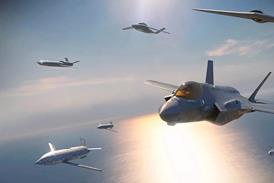Things are no longer black and white for the Skunk Works. The still-secretive Lockheed Martin unit is having to adjust to the reality that much of its future business opportunities are in the commercial, and not the classified, arena.
Not that the two worlds are so vastly different - both favour the low overhead, rapid response, entrepreneurial culture that has long set the Skunk Works apart from other defence aerospace manufacturers. This is one reason why Lockheed Martin has not extended the unit's advanced development remit to include its other manufacturing operations, as Boeing has with the Phantom Works.
Instead, the Palmdale, California-based Skunk Works teams with other Lockheed Martin businesses bidding for specific programmes. Leadership of fighter and transport aircraft advanced development remains with the relevant Aeronautics sector businesses, but the Skunk Works supplies its expertise in stealth technology and rapid prototyping. For example, it is responsible for final assembly of Lockheed Martin's two X-35 JSF concept demonstrators (below).

The Skunk Works operates as a semi-autonomous entity within Lockheed Martin. Its ability to operate as a virtually self-contained unit is encouraged because of past successes. Lockheed Martin believes the approach will continue to reap benefits as it keeps costs low and productivity high.
The stand-alone nature of the company, removed as it is from the entanglements of the corporate structure, is also better suited to producing the quick and innovative responses for which it is well known, says Lockheed Martin. It cites the example of the F-117 stealth fighter, which cost $700 million to develop at the Skunk Works, compared with $1.1 billion for the F-16 and $2.5 billion for the F-15.
"We will put out a quote for an [engineering and manufacturing development contract] for a third of the others," says Skunk Works president Paul Martin.
By early 1999, the company was working on 10 different active aircraft programmes "and that's only what we can divulge", says Martin. Since then, the DarkStar UAV has been cancelled, but others in the list include: tactical UAVs, JSF, F-22, U-2 upgrades, and C-130 variants. It is also known to be working on at least two classified programmes.
The company is also building the X-33 subscale, suborbital technology demonstrator for Lockheed Martin's planned VentureStar single-stage-to-orbit reusable launch vehicle. The Skunk Works is designing the full-scale vehicle, which would be developed as a commercial venture (below).

The unit is also supporting development of the stealthy Joint Air-to-Surface Standoff Missile at Lockheed Martin's Electronics &Missiles sector plant in Orlando and the setting up of production in Troy, Alabama.
Work continues with Gulfstream on a supersonic business jet (SSBJ) study. "The Skunk Works brings a big technology base to that," says Martin. The company believes that stealth shaping technology can be brought to bear to minimise the sonic boom produced by a Mach 2.2, 10-passenger, 7,400km-range aircraft. Lockheed Martin continues to talk to NASA about funding for an SSBJ X-plane demonstrator. "We will focus on what's critical to make it proceed, and then we'll look for partners," says Martin.
The company has also been looking for some time at a huge lighter-than-air freighter. At first the project appeared to be in the public forum, but then, for some reason, it became highly classified. Old habits appear to die hard at the Skunk Works.
Source: Flight International























